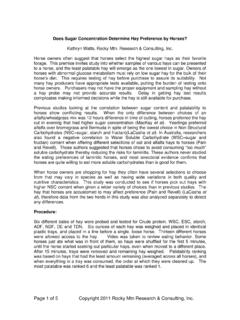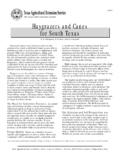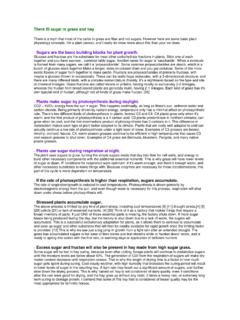Transcription of Alfalfa: The High-Quality Hay for Horses
1 alfalfa . The High-Quality hay for Horses Glenn E. Shewmaker University of Idaho Dan Undersander University of Wisconsin Laurie M. Lawrence University of Kentucky Garry D. Lacefield University of Kentucky 2. lfalfa is often the pre- Food especially forage passes rela- A ferred forage for Horses because of its high quality , high digestibility, and good roughage value. Well-preserved alfalfa hay should be the foundation of a feeding program for young growing Horses , recreational The horse's digestive system H.
2 Orses evolved as grazing animals. Compared to most other non- ruminant species, the horse has a tively rapidly through the stomach and small intestine, but can be retained for many hours in the hind gut (cecum). The hind gut is populated by a diverse microbial population that digests the fibrous components of hay and pasture. relatively small stomach, a normal-sized The horse's digestive tract is generally Horses , and active Horses . This publica- small intestine, and an enlarged hind gut not as efficient at digesting fiber as the tion describes the horse's digestive (figure 1).
3 This arrangement makes digestive tract of a cow or sheep. system and nutritional needs and how Horses better adapted to grazing contin- However, for High-Quality hays such as to select alfalfa hay. It provides informa- uously than to eating one or two large early bloom alfalfa hay, the difference is tion on purchasing, storing, and feeding meals a day. Compare the size of a horse's much smaller than for lower quality hays alfalfa hay; and uses science to discuss stomach (figure 2) to the volume of hay such as late-maturity grass hays.
4 Myths and realities of feeding Horses . a horse will consume in a day, and it's High-Quality hay (or pasture) can be an easy to see why Horses should be allowed excellent source of nutrients for most access to forage throughout the day. classes of Horses , and in most cases should be the predominant type of feed in a horse's diet. However, some classes of Horses will require supplementation of their diet with a concentrate. A con- Figure 1. The digestive tract and internal organs of the horse. centrate feed can be a plain grain such as oats or corn, or it can be a commer- cially manufactured mixture of grains and other feed ingredients.
5 Concentrate cecum bladder spleen esophagus feeds are higher in energy than hay because the cereal grains contain more rectum stomach nonstructural carbohydrates, especially starch. trachea heart colon liver small Figure 2. A model of a horse's stomach from an 1100-lb horse shown intestine next to the daily ration (15 lb) of hay. Because of their relatively small stomachs, Horses are better adapted to eating forage all day long instead of eating one or two large meals each day. A L F A L F A. 3. In Horses , starch can be digested in the also shown.
6 These concentrations are small intestine and absorbed as glucose. Meeting the based on average expected feed intakes Research has demonstrated that when of the Horses in each physiological class. large amounts of starch are fed, the nutritional needs To accurately determine the appropriate capacity of the small intestine to digest the starch will be overloaded. The undi- of Horses dietary concentration for a nutrient, it is necessary to know the feed intake of the gested starch is moved on to the large orse nutrient needs change with intestine where it is fermented.
7 Fermentation of starch in the large intes- tine is less energetically efficient than H age and production state. Very young Horses usually require the horse. For example, if a horse consumes 25 lb of feed per day and it requires 2 lb of crude protein, then the feed must most nutrient-dense diets because they contain 8% crude protein (2 25). digestion and absorption from the small are growing rapidly. The diets have to be However, if the horse only consumes 20. intestine. More importantly, fermenta- nutrient dense to meet the animal's high lb of feed per day, then the feed must tion of excess starch in the large intes- nutrient requirements and limited intake contain 10% crude protein to provide tine can result in digestive problems capacity.
8 As Horses age, diets that are the needed crude protein each day. such as diarrhea, colic, and, in severe less nutrient dense are usually required. Most Horses will consume at least 2 lb of cases, founder. Lactating mares and Horses with strenu- feed (forage and concentrate, 90% dry When an 1100-lb horse consumes a ous physical activities have much higher matter) for every 100 lb of body weight. meal containing more than lb of requirements than Horses that are kept However, if very low- quality forage is starch, there is potential for some undi- at maintenance or are used for light fed, feed intake might be less.
9 Gested starch to reach the large intes- recreational riding. Conversely, if highly palatable feed is tine. Cereal grains vary in starch content, Table 1 shows the approximate amounts offered, intake may increase. Some so the actual amount of grain that can of several nutrients required by Horses in Horses , especially lactating mares and be fed without starch by-passing to the different physiological stages on a daily growing Horses , may consume 3 lb of large intestine will vary also. Corn can basis. These values may need to be feed per 100 lb of body weight.
10 Contain 60 70% starch whereas oats adjusted for specific Horses , particularly contain 45 55% starch. Many commer- if they are exposed to unusually hot or cially manufactured feeds will have a cold weather. For some nutrients, the starch content of 45 55%, although approximate dietary concentrations are feeds with lower amounts of starch are becoming more available. If a horse is fed a concentrate containing 50% starch, the amount that could be fed in a single Table 1. Recommended nutrient intakes for Horses with an expected meal with minimal starch by-pass to the mature body weight of 1100 lb.







